Class 8 Maths Chapter 4 Practical Geometry All Exercise NCERT Solutions
- Class 8 Maths Chapter 4 Practical Geometry Exercise 4.1
- Class 8 Maths Chapter 4 Practical Geometry Exercise 4.2
- Class 8 Maths Chapter 4 Practical Geometry Exercise 4.3
- Class 8 Maths Chapter 4 Practical Geometry Exercise 4.4
- Class 8 Maths Chapter 4 Practical Geometry Exercise 4.5
NCERT Solutions For Class 8 Maths Chapter 4 Practical Geometry Exercise 4.1
Ex 4.1 Class 8 Maths Question 1.
Construct the following quadrilaterals.
(i) Quadrilateral ABCD
AB = 4.5 cm, BC = 5.5 cm, CD = 4 cm, AD = 6 cm, AC = 7 cm
(ii) Quadrilateral JUMP
JU = 3.5 cm, UM = 4 cm, MP = 5 cm, PJ = 4.5 cm, PU = 6.5 cm
(iii) Parallelogram MORE
OR = 6 cm, RE = 4.5 cm, EO = 7.5 cm
(iv) Rhombus BEST
BE = 4.5 cm, ET = 6 cm
Solution:
(i) We have to draw first rough sketch.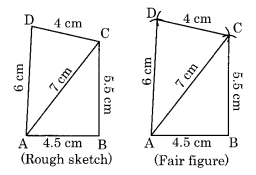
Construction:
Step I: Draw AB = 4.5 cm
Step II: Draw an arc with centre B and radius 5.5 cm.
Step III: Draw another arc with centre A and radius 7 cm to meet the previous arc at C.
Step IV: Draw an arc with centre C and radius 4 cm.
Step V: Draw another arc with centre A and radius 6 cm to cut the former arc at D.
Step VI: Join BC, AC, CD and AD.
(ii) We have to draw the first rough sketch.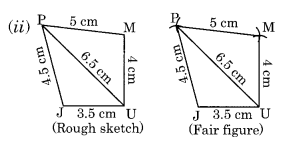
Thus ABCD is the required quadrilateral.
Construction:
Step I: Draw JU = 3.5 cm.
Step II: Draw an arc with centre J and radius 4.5 cm.
Step III: Draw another arc with centre U and radius 6.5 cm to meet the previous arc at P.
Step IV: Join JP and UP.
Step V: Draw an arc with centre U and radius 4 cm.
Step VI: Draw another arc with centre P and radius 5 cm to meet the previous arc at M.
Step VII: Join UM and PM.
Thus, JUMP is the required quadrilateral.
(iii) We have to draw the first rough sketch.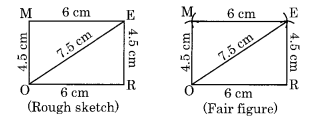
Construction: (Opposite sides of a parallelogram are equal)
Step I: Draw OR = 6 cm.
Step II: Draw an arc with centre R and radius 4.5 cm.
Step III: Draw another arc with centre O and radius 7.5 cm to meet the previous arc at E.
Step IV: Join RE and OE.
Step V: Draw an arc with centre E and radius 6 cm.
Step VI: Draw another arc with centre O and radius 4.5 cm to meet the former arc at M.
Step VII: Join EM and OM.
Thus, MORE is the required parallelogram.
(iv) We have to draw first rough sketch.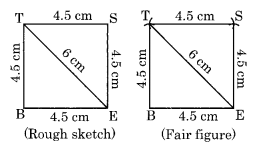
Construction: (All sides of a rhombus are equal)
Step I: Draw BE = 4.5 cm
Step II: Draw an arc with centre B and radius 4.5 cm.
Step III: Draw another arc with centre E and radius 6 cm to meet the previous arc at T.
Step IV: Join BT and ET.
Step V: Draw two arcs with centres E and T with equal radii 4-5 cm to meet each other at S. .
Step VI: Join ES and TS.
Thus, BEST is the required rhombus.
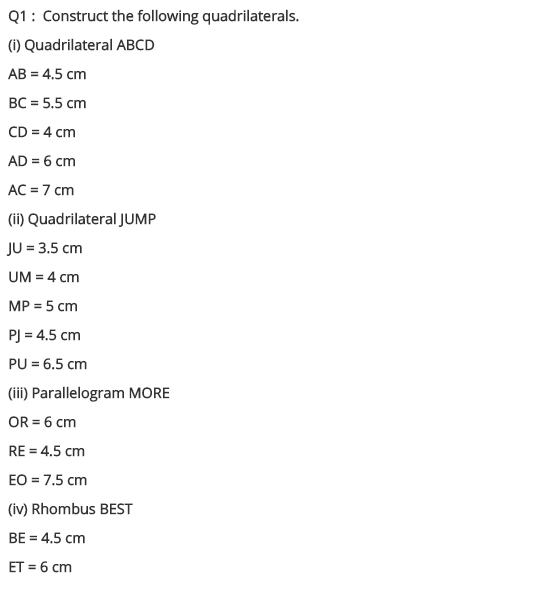
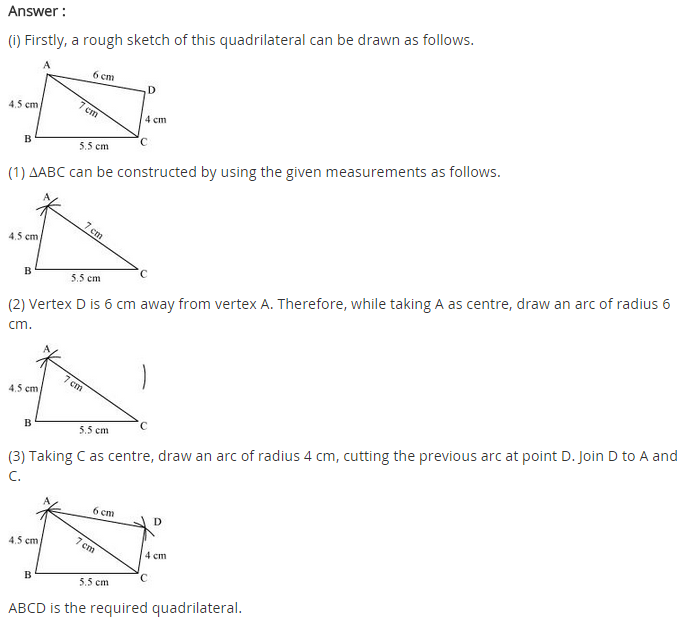
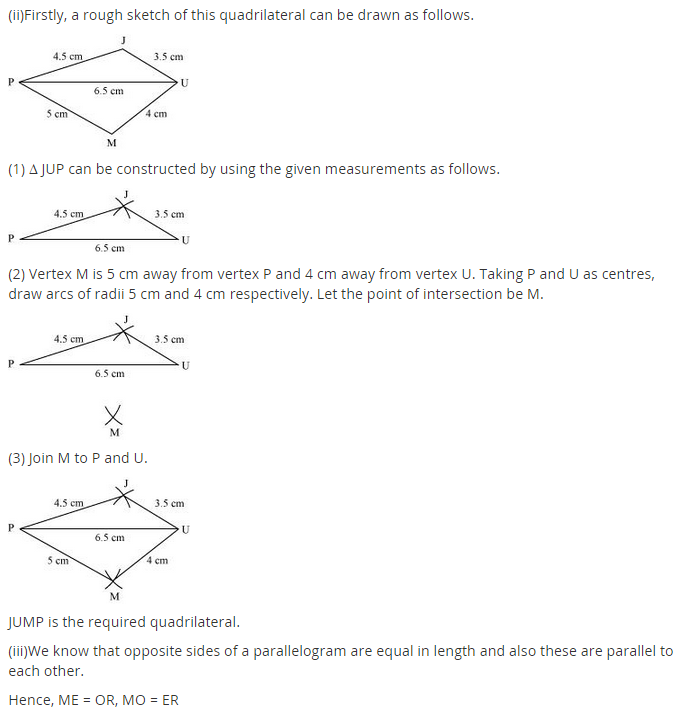
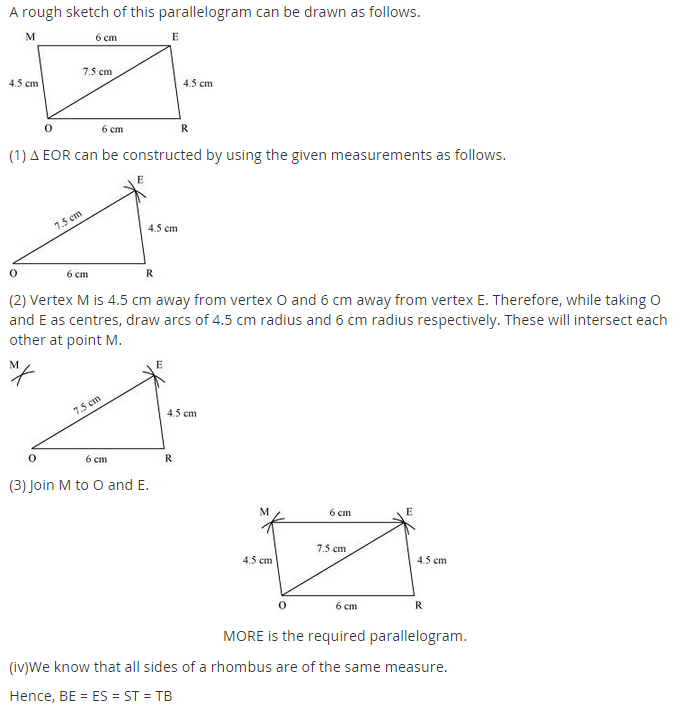
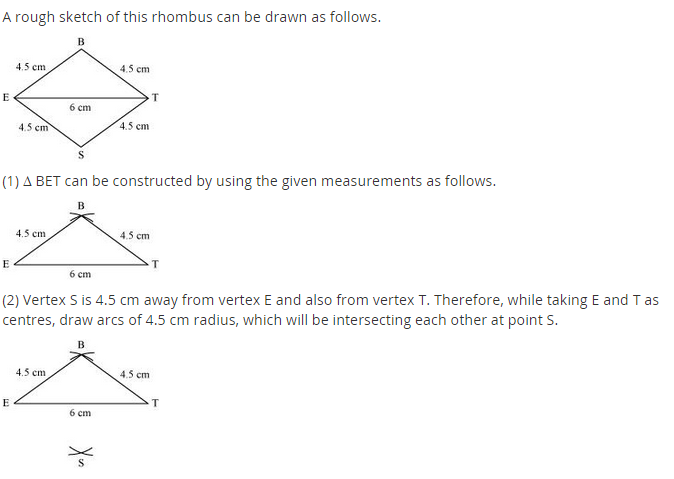
NCERT Solutions for Class 8 Maths Chapter 4 Practical Geometry Exercise 4.2
Ex 4.2 Class 8 Maths Question 1.
Construct the following quadrilaterals.
(i) Quadrilateral LIFT
LI = 4 cm
IF = 3 cm
TL = 2.5 cm
LF = 4.5 cm
IT = 4 cm
(ii) Quadrilateral GOLD
OL = 7.5 cm
GL = 6 cm
GD = 6 cm
LD = 5 cm
OD = 10 cm
(iii) Rhombus BEND
BN = 5.6 cm
DE = 6.5 cm
Solution:
(i) Construction: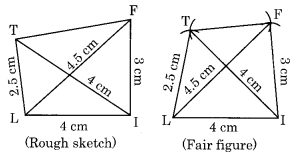
Step I: Draw LI = 4 cm.
Step II: Draw an arc with centre I and radius 3 cm.
Step III: Draw another arc with centre L and radius 4.5 cm to meet the former arc at F.
Step IV: Join LF and IF.
Step V: Draw an arc with centre L and radius 2.5 cm.
Step VI: Draw another arc with centre I and radius 4 cm to meet the previous arc at T.
Step VII: Join LT and IT.
Thus LIFT is the required quadrilateral.
(ii) Construction: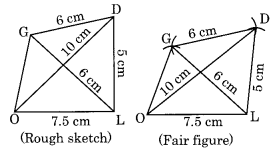
Step I: Draw OL = 7.5 cm
Step II: Draw an arc with centre O and radius 10 cm.
Step III: Draw another arc with centre L and radius 5 cm to meet the previous arc at D.
Step IV: Join OD and LD.
Step V: Draw an arc with centre L and D with equal radii of 6 cm to meet each other at G.
Step VI: Join LG and DG.
Thus GOLD is the required quadrilateral.
(iii) Construction: (The diagonals of a rhombus bisect each other at the right angle)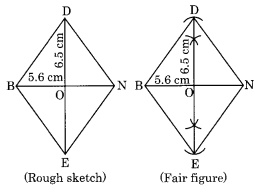
Step I: Draw BN = 5.6 cm.
Step II: Draw the right bisector of BN at O.
Step III: Draw two arcs with centre O and radius
Step IV: Join BE, EN, ND and BD.
Thus, BEND is the required rhombus.
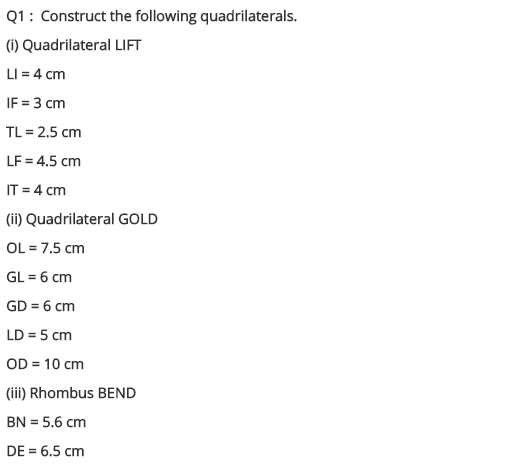
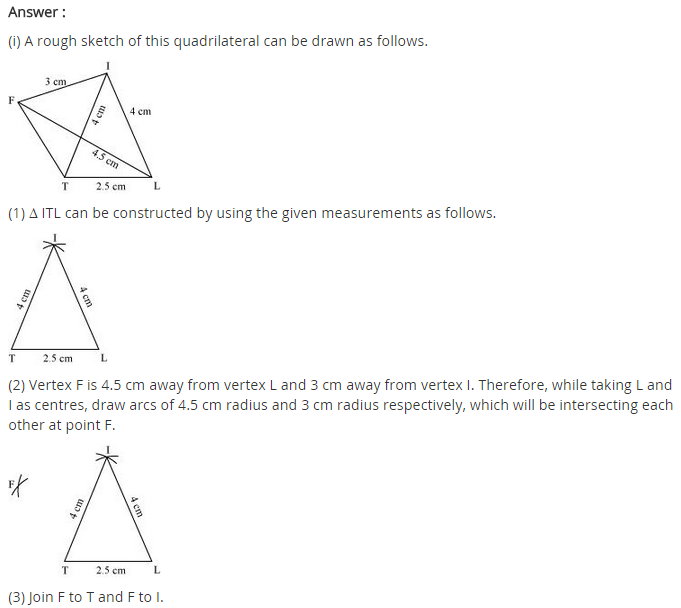
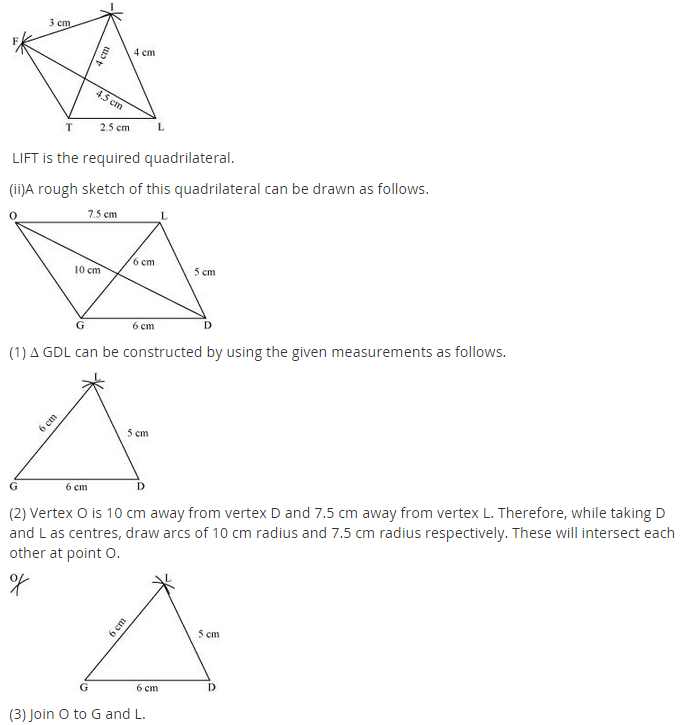
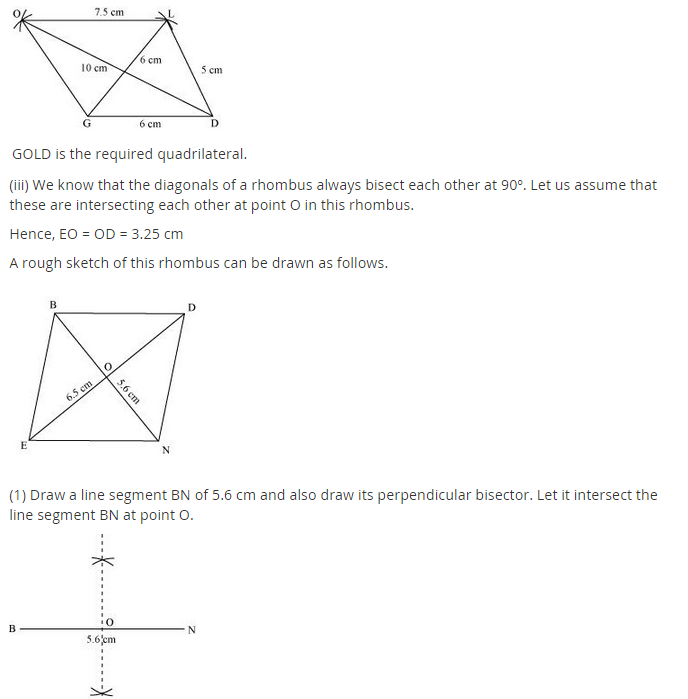
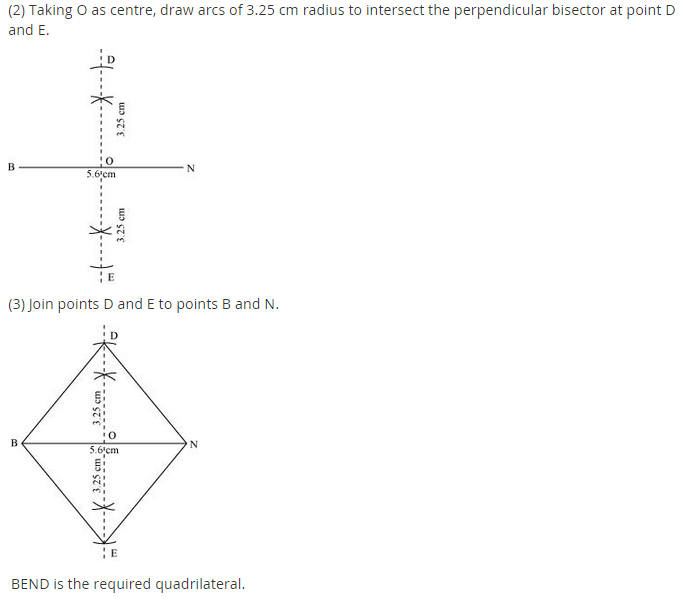
NCERT Solutions for Class 8 Maths Chapter 4 Practical Geometry Exercise 4.3
Ex 4.3 Class 8 Maths Question 1.
Construct the following quadrilaterals:
(i) Quadrilateral MORE
MO = 6 cm, ∠R = 105°, OR = 4.5 cm, ∠M = 60°, ∠O = 105°
(ii) Quadrilateral PLAN
PL = 4 cm, LA = 6.5 cm, ∠P = 90°, ∠A = 110°, ∠N = 85°
(iii) Parallelogram HEAR
HE = 5 cm, EA = 6 cm, ∠R = 85°
(iv) Rectangle OKAY
OK = 7 cm, KA = 5 cm
Solution:
(i) Construction:
Step I: Draw OR = 4.5 cm
Step II: Draw two angles of 105° each at O and R with the help of protactor.
Step III: Cut OM = 6 cm.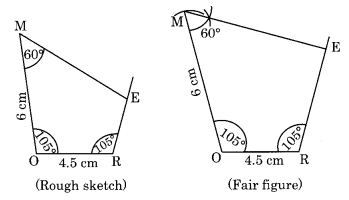
Step IV: Draw an angle of 60° at M to meet the angle line through R at E.
Thus, MORE is the required quadrilateral.
(ii) Construction: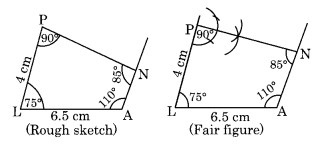
Step I: Draw LA = 6.5 cm
Step II: Draw an angle of 75° at L and 110° at A with the help of a protractor.
[∵ 360° – (110° + 90° + 85°) = 75°]
Step III: Cut LP = 4 cm.
Step IV: Draw an angle of 90° at P which meets the angle line through A at N.
Thus PLAN is the required quadrilateral.
(iii) Construction: (Opposite sides of a parallelogram are equal)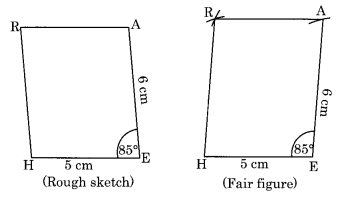
Step I: Draw HE = 5 cm.
Step II: Draw an angle of 85° at E and cut EA = 6 cm.
Step III: Draw an arc with centre A and radius 5 cm.
Step IV: Draw another arc with centre H and radius 6 cm to meet the previous arc at R.
Step V: Join HR and AR
Thus, HEAR is the required parallelogram.
(iv) Construction:
(Each angle of a rectangle is 90° and opposite sides are equal.)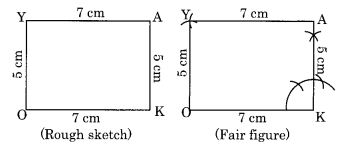
Step I: Draw OK = 7 cm.
Step II: Draw the angle of 90° at K and cut KA = 5 cm.
Step III: Draw an arc with centre O and radius 5 cm.
Step IV: Draw another arc with centre A and radius 7 cm to meet the previous arc at Y.
Step V: Join OY and AY.
Thus OKAY is the required rectangle.
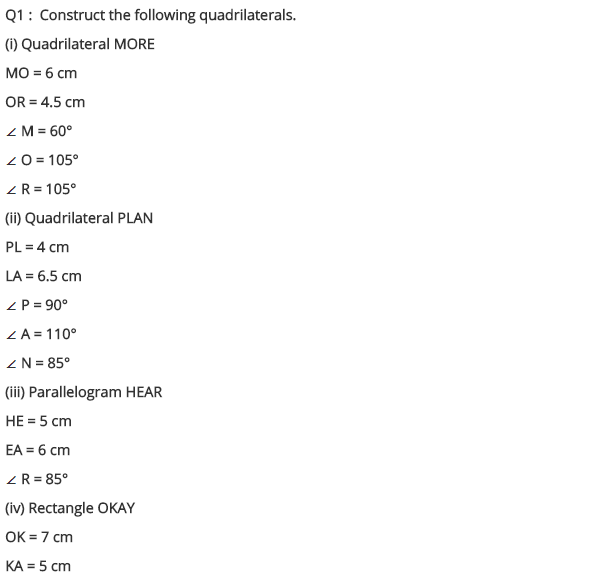
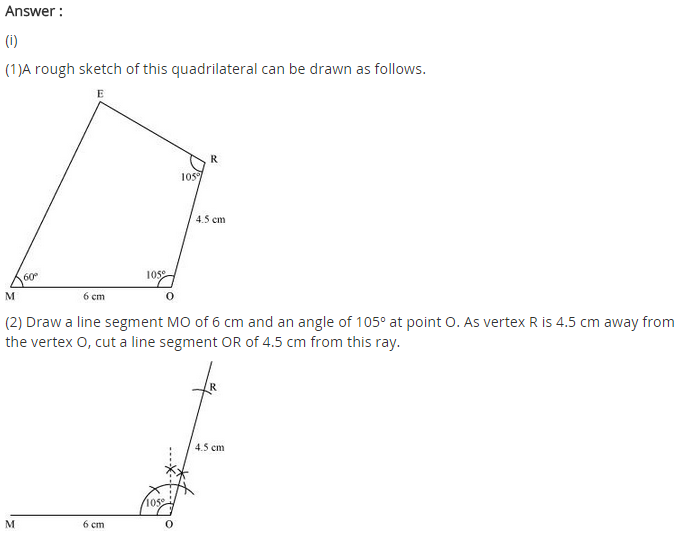
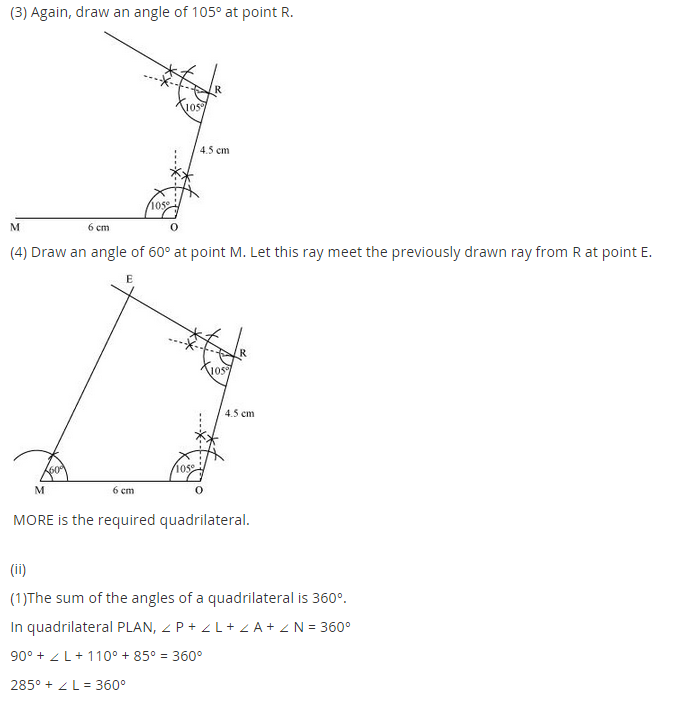
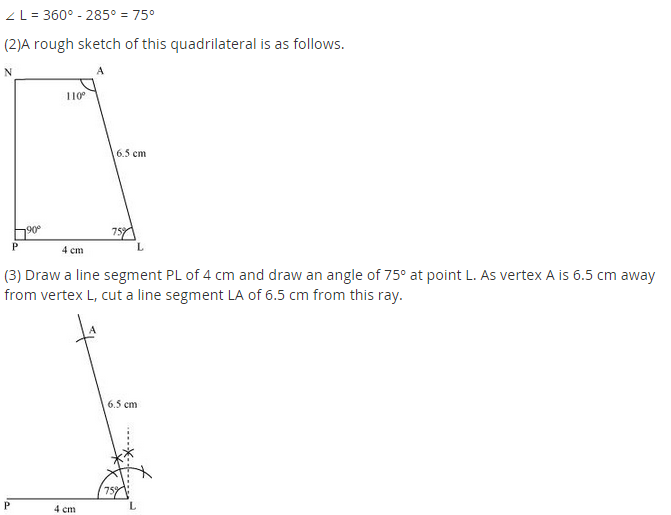
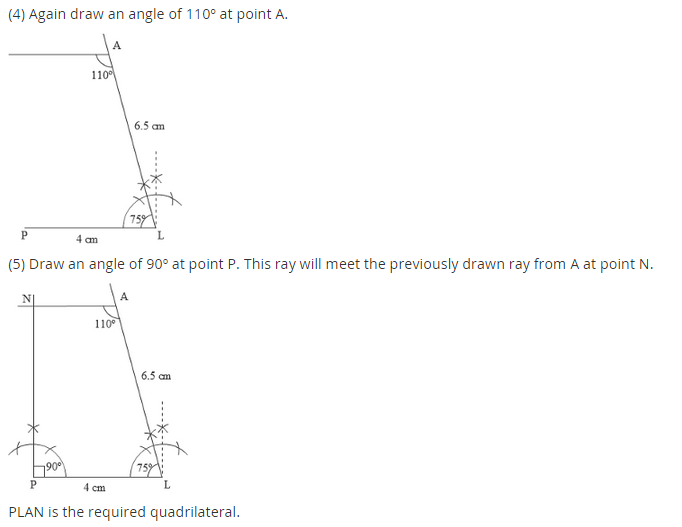
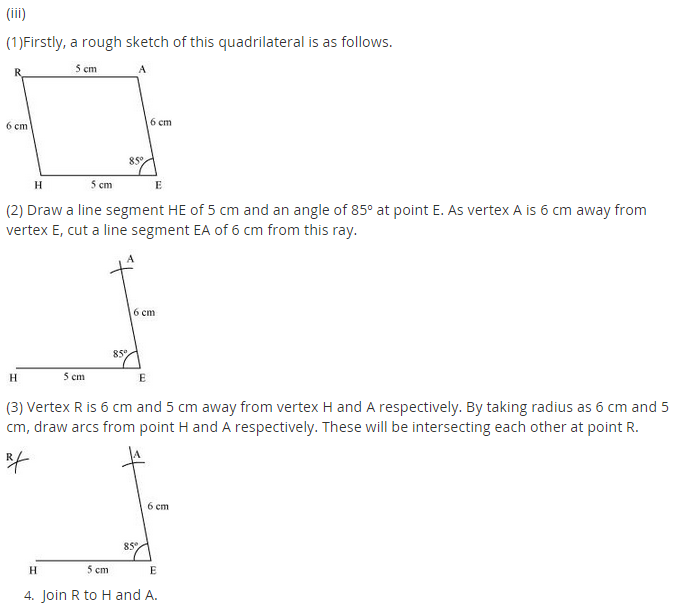
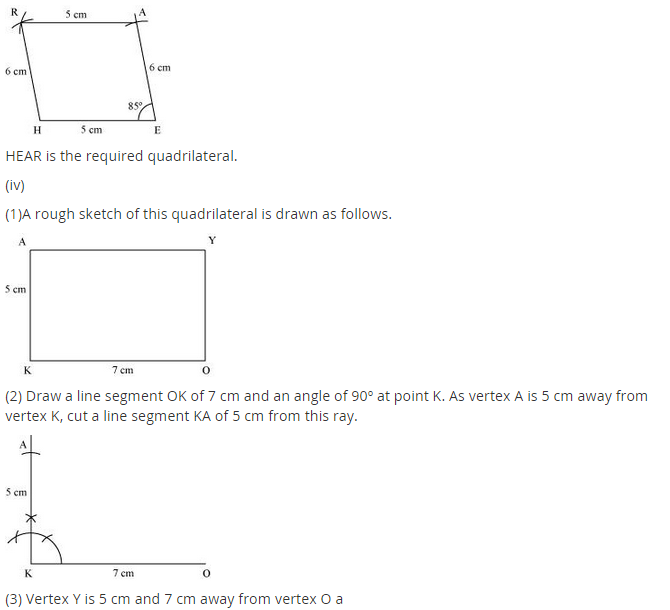
NCERT Solutions for Class 8 Maths Chapter 4 Practical Geometry Exercise 4.4
Ex 4.4 Class 8 Maths Question 1.
Construct the following quadrilaterals:
(i) Quadrilateral DEAR
DE = 4 cm, EA = 5 cm, AR = 4.5 cm, ∠E = 60°, ∠A = 90°
(ii) Quadrilateral TRUE
TR = 3.5 cm, RU = 3 cm, UE = 4.5 cm, ∠R = 75°, ∠U = 120°
Solution:
(i) Construction: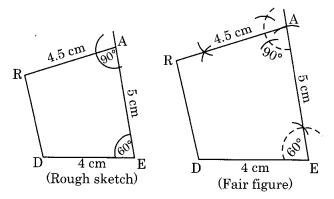
Step I: Draw DE = 4 cm.
Step II: Draw an angle of 60° at E.
Step III: Draw an arc with centre E and radius 5 cm to meet the angle line at A.
Step IV: Draw an angle of 90° at A and cut AR = 4.5 cm.
Step V: Join DR.
Thus, DEAR is the required quadrilateral.
(ii) Construction: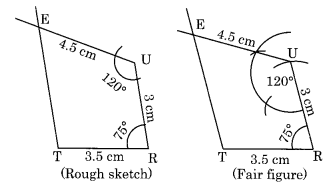
Step I: Draw TR = 3.5 cm
Step II: Draw an angle of 75° at R and cut RU = 3 cm.
Step III: Draw an angle of 120° at U and cut UE = 4.5 cm.
Step IV: Join TE.
Thus, TRUE is the required quadrilateral.
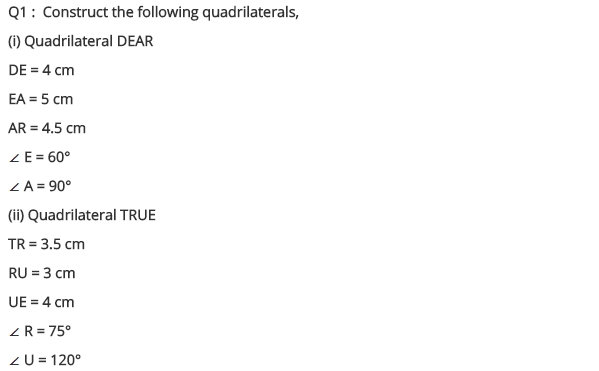
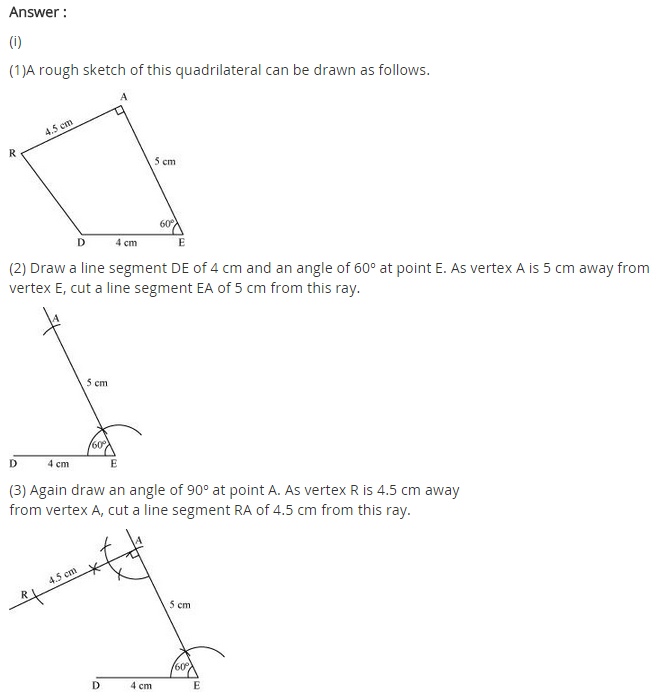
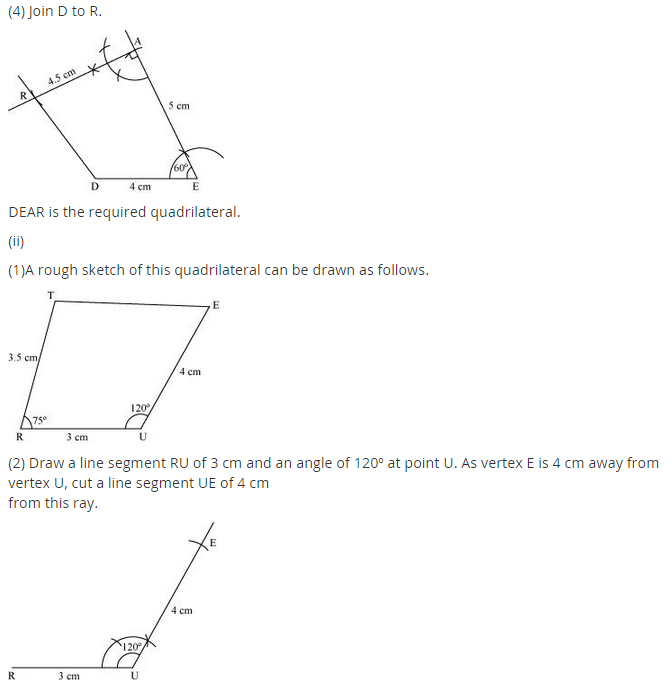
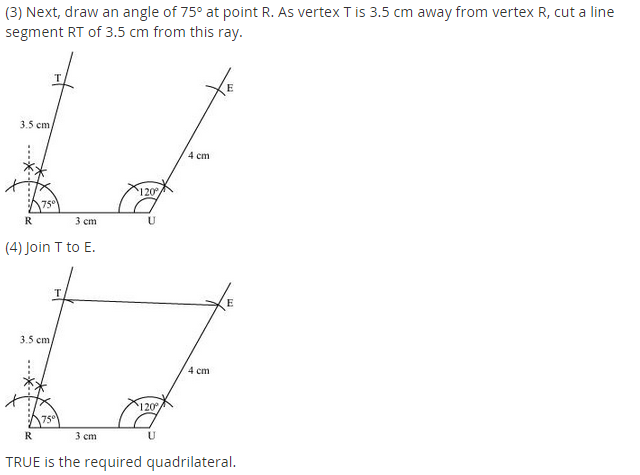
NCERT Solutions for Class 8 Maths Chapter 4 Practical Geometry Exercise 4.5
Draw the following:
Ex 4.5 Class 8 Maths Question 1.
The square READ with RE = 5.1 cm.
Solution:
Construction: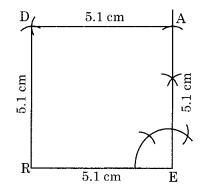
Step I: Draw RE = 5.1 cm.
Step II: Draw an angle of 90° at E and cut EA = 5.1 cm.
Step III: Draw two arcs from A and R with radius 5.1 cm to cut each other at D.
Step IV: Join RD and AD.
Thus, READ is the required square.
Ex 4.5 Class 8 Maths Question 2.
A rhombus whose diagonals are 5.2 cm and 6.4 cm long.
Solution:
Construction: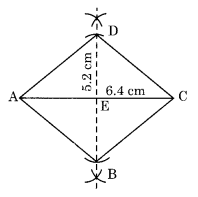
Step I: Draw AC = 6.4 cm.
Step II: Draw the right bisector of AC at E.
Step III: Draw two arcs with centre E and radius =
Step IV: Join AD, AB, BC and DC.
Thus ABCD is the required rhombus.
Ex 4.5 Class 8 Maths Question 3.
A rectangle with adjacent sides of lengths 5 cm and 4 cm.
Solution:
Construction: Let the two adjacent sides of a rectangle PQRS be PQ = 5 cm and QR = 4 cm.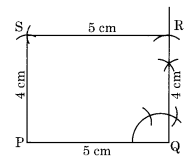
Step I: Draw PQ = 5 cm.
Step II: Draw an angle of 90° at Q and cut QR = 4 cm.
Step III: Draw an arc with centre R and radius 5 cm.
Step IV: Draw another arc with centre P and radius 4 cm to meet the previous arc at S.
Step V: Join RS and PS.
Thus, PQRS is the required rectangle.
Ex 4.5 Class 8 Maths Question 4.
A parallelogram OKAY where OK = 5.5 cm and KA = 4.2 cm. Is it unique?
Solution:
Construction:
Step I: Draw OK = 5.5 cm.
Step II: Draw an angle of any measure (say 60°) at K and cut KA = 4.2 cm.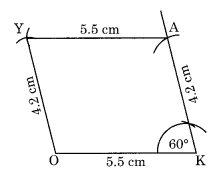
Step III: Draw an arc with centre A and radius of 5.5 cm.
Step IV: Draw another arc with centre O and radius 4.2 cm to cut the previous arc at Y.
Step V: Join AY and OY.
Thus, OKAY is the required parallelogram.
No, it is not a unique parallelogram. The angle at K can be of measure other than 60°.
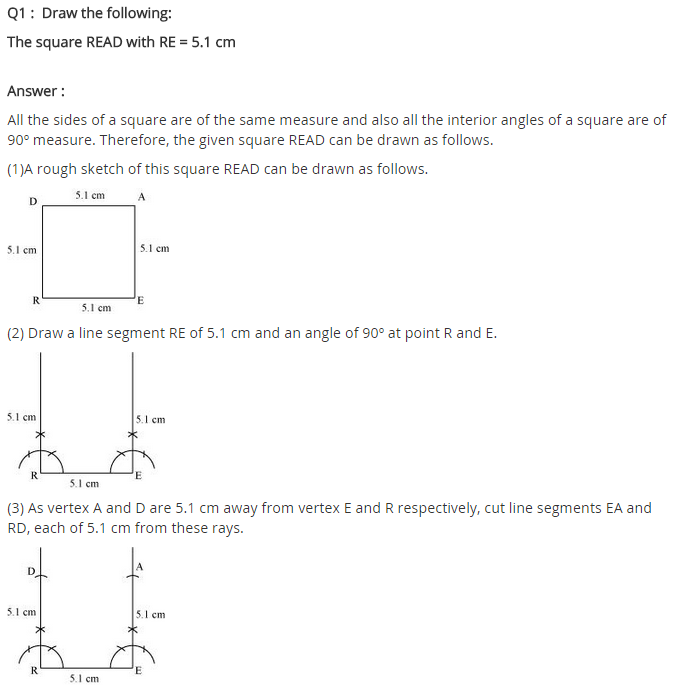

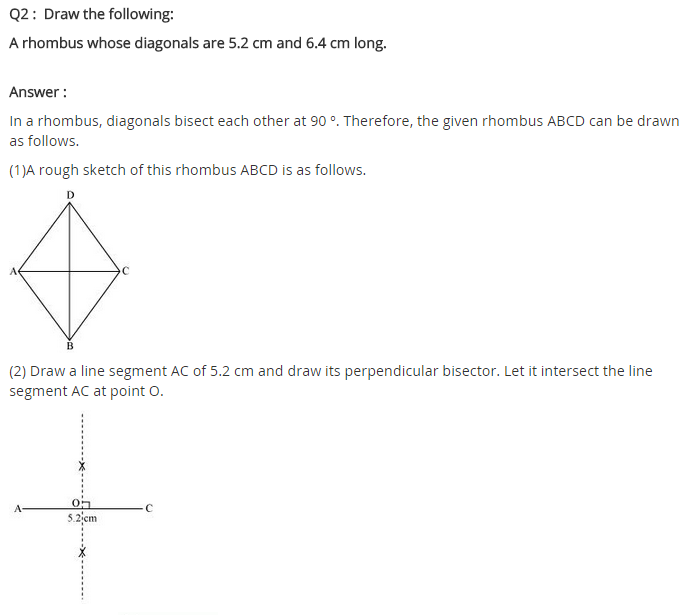
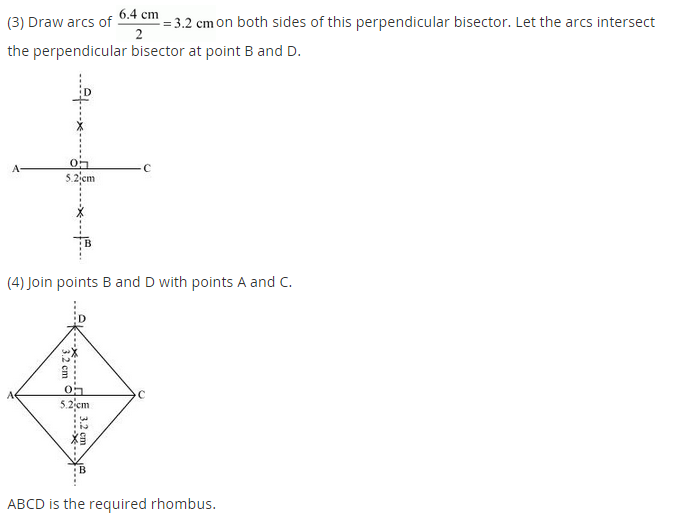
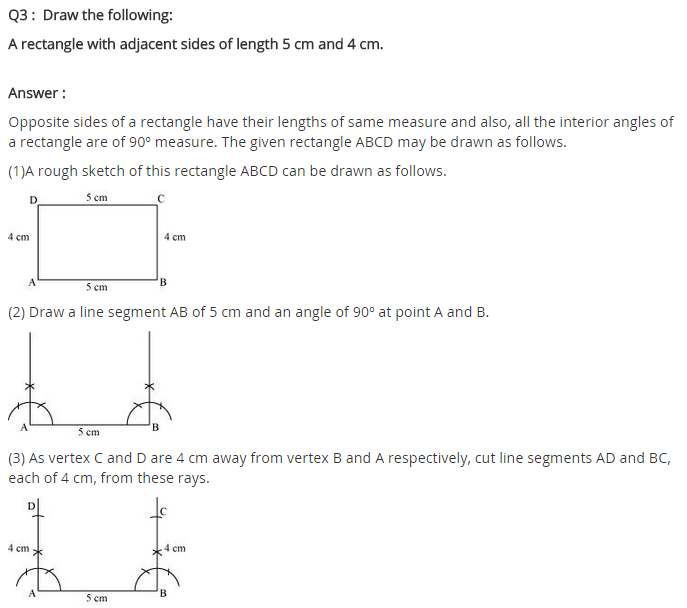

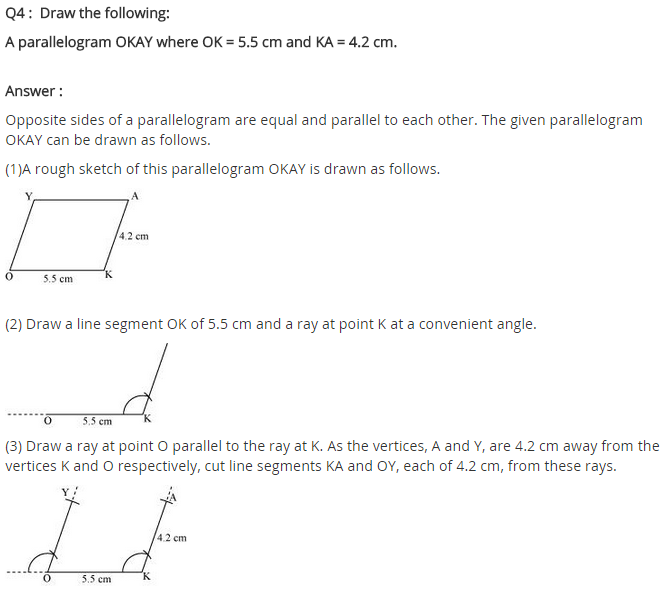

- Chapter 1 Rational Numbers
- Chapter 2 Linear Equations in One Variable
- Chapter 3 Understanding Quadrilaterals
- Chapter 4 Practical Geometry
- Chapter 5 Data Handling
- Chapter 6 Squares and Square Roots
- Chapter 7 Cubes and Cube Roots
- Chapter 8 Comparing Quantities
- Chapter 9 Algebraic Expressions and Identities
- Chapter 10 Visualising Solid Shapes
- Chapter 11 Mensuration
- Chapter 12 Exponents and Powers
- Chapter 13 Direct and Indirect proportions
- Chapter 14 Factorisation
- Chapter 15 Introduction to Graphs
- Chapter 16 Playing with Numbers
.png)
.png)